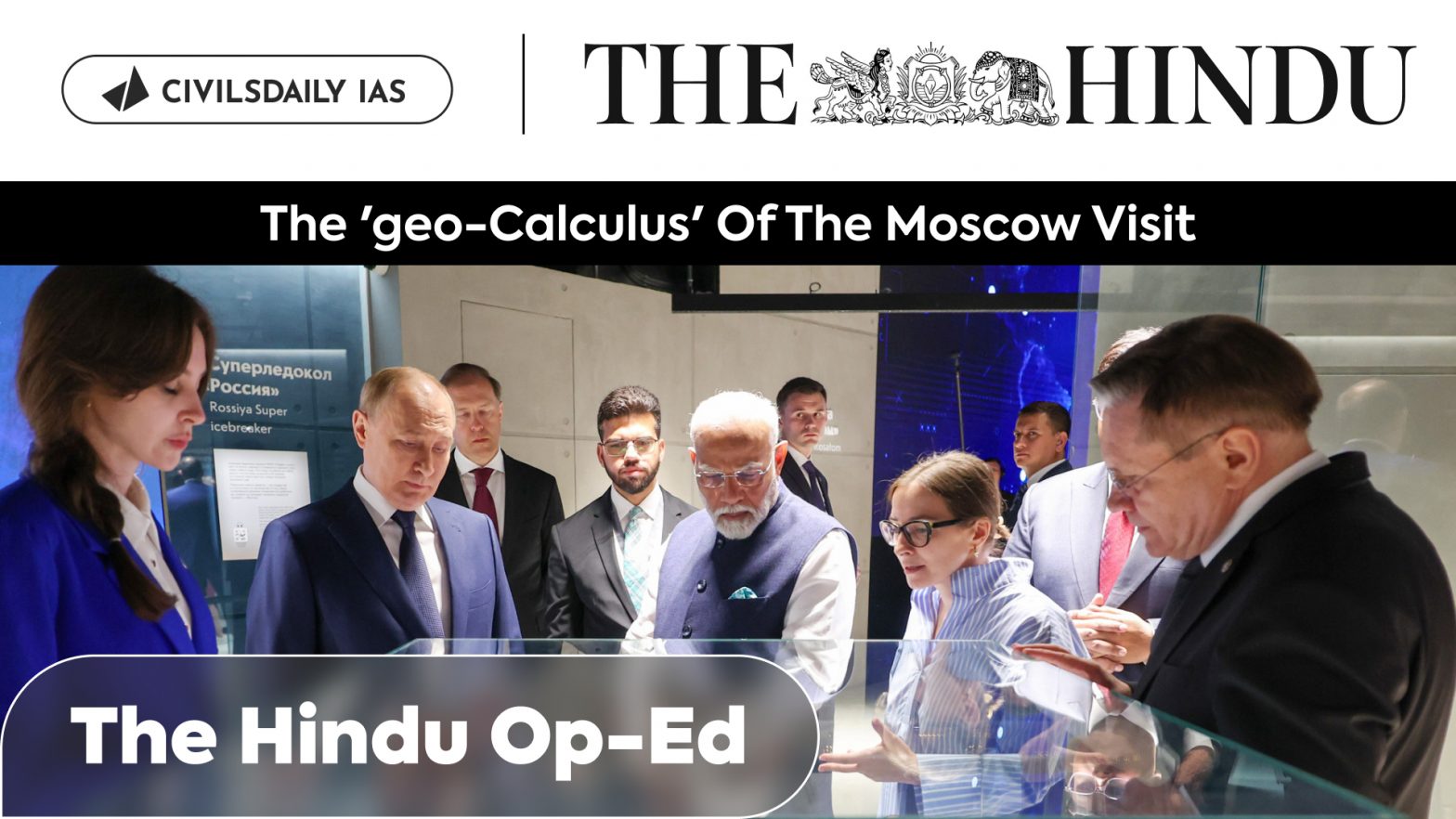| PYQ Relevance: Mains: Q1 Critically examine the aims and objectives of SCO. What importance does it hold for India? (UPSC IAS/2021) Q2 How is the S-400 air defence system technically superior to any other system presently available in the world? (UPSC IAS/2021) Prelims: Q Recently, India signed a deal known as ‘Action Plan for Prioritization and Implementation of cooperation Areas in the Nuclear Field’ with which of the following countries? (2019) (a) Japan (b) Russia (c) The United Kingdom (d) The United States of America |
Note4Students:
Prelims: Bordering countries with Russia and China;
Mains: Geopolitics dynamics as per India;
Mentor comments: India-Russia relations have evolved significantly, particularly following Russia’s invasion of Ukraine. Bilateral trade surged to approximately $65 billion in 2022, driven by discounted oil imports, which accounted for a substantial portion of trade. Despite Western sanctions, India continues to maintain strong ties with Russia, focusing on energy supplies and defense cooperation. The two nations are exploring new payment mechanisms and investment opportunities to strengthen economic ties. However, India’s diversification in defense procurement poses challenges to this traditional partnership, highlighting the need for a strategic shift in their relationship.
Let’s learn!
__
Why in the News?
Two weeks after Prime Minister Narendra Modi’s visit to Russia, marking his first bilateral trip in the government’s third tenure.
Assessment of the conflict in Ukraine
- Evolution of the Conflict: The conflict began with Russia’s invasion of Ukraine on February 24, 2022, and has entered its third year with no clear resolution in sight. Initially expected to be a swift operation, the war has evolved into a prolonged military stalemate.
- Casualties and Displacement: The war has resulted in significant human costs, with over 10,000 civilians killed and nearly 20,000 wounded according to the United Nations.
- More than 14 million people have been displaced, with 6 million now living as refugees in various countries.
- Territorial Control: As of now, Russia controls approximately 17% of Ukrainian territory, a decrease from the 20% occupied early in the conflict. This indicates some resilience on Ukraine’s part despite ongoing military challenges.
- Economic Impact: The conflict has imposed heavy economic burdens on both countries. Estimates suggest that Ukraine has suffered losses exceeding $500 billion, while Russia has incurred substantial financial sanctions, losing over $300 billion due to international responses.
- Military Stalemate: The military situation has stabilized, with Russia managing to hold its positions in eastern Ukraine. However, Ukraine continues to face shortages of arms and personnel, complicating its counteroffensive efforts.
- International Dynamics: The conflict has highlighted divisions within the West regarding support for Ukraine For example, the United States, the United Kingdom, and Poland have provided significant military aid, while others, such as Germany and France, have been more cautious,
- Global South Perspective: Many countries in the Global South disapprove of Russia’s actions but also resist unilateral sanctions imposed by Western nations. This reflects a broader geopolitical divide where nations seek to navigate their interests without fully aligning with either side.
- Future Prospects: The likelihood of a “frozen conflict” appears to be increasing, with both sides entrenched in their positions. The potential for a peace process, as indicated by upcoming conferences, suggests that diplomatic efforts may be necessary to address the ongoing stalemate.
- India’s Position: India has maintained a neutral stance, abstaining from UN votes condemning Russia and increasing its oil imports from Russia. While providing humanitarian aid to Ukraine, India has refrained from deeper military or infrastructural support, reflecting its strategic interests in maintaining relations with both Russia and Western nations.
Geopolitics dynamics as per India:
- Strategic Autonomy and Geopolitical Signaling: Prime Minister Narendra Modi’s visit to Moscow, following the cancellation of his visit to Astana, Kazakhstan for the SCO Summit, signifies India’s strategic choice to prioritize a meeting with Russian President Vladimir Putin over a joint appearance with Chinese President Xi Jinping.
- India’s Strategic Concerns: India aims to maintain Russia as a strategic ally in the face of continuous tensions with China at the Line of Actual Control (LAC).
- Western Geopolitical Dynamics: The Biden administration has strengthened alliances like AUKUS (Australia-U.K.-U.S.) for nuclear submarines and engaged with “Quad Plus” countries, including New Zealand, South Korea, Vietnam, and the Philippines leading dilution of the main objective of QUAD.
- The U.S. hosted the “AP-4” (Australia, New Zealand, South Korea, and Japan) leaders during the NATO summit in Washington, underscoring its strategic focus in the region.
- India’s Position within the Quad: India’s reluctance to make the Quad (India, Japan, Australia, U.S.) a strategic concept risks limiting its utility to Indo-Pacific partners compared to other emerging alliances.
- Broader Geopolitical Strategy: The visit to Russia highlights India’s commitment to its strategic autonomy and the importance of diversifying its strategic options.
Geo-Economic Thrust of Modi’s Visit to Russia
- Geo-Economic Thrust of Modi’s Visit to Russia Strengthening Trade Relations: The visit underscores a significant increase in India-Russia trade, which surged by 66% to $65 billion last year, driven largely by discounted Russian oil imports.
- Focus on Energy Supplies: The joint statement from the Modi-Putin summit emphasized enhancing cooperation in energy supplies, particularly oil and LNG.
- Circumventing Sanctions: The summit outlined action items aimed at circumventing Western sanctions.
- Maritime Connectivity: The discussion included plans to operationalize the Chennai-Vladivostok maritime corridor.
- Defence Cooperation: Despite diversifying its defence procurement, India continues to rely significantly on Russia for military hardware. The visit aimed to address concerns regarding delays in defence supplies.
Conclusion: India’s strategic autonomy, underscored by Modi’s visit to Russia, focuses on strengthening geo-economic ties, energy cooperation, and diversified alliances, balancing its relations with Russia and the West amidst global conflicts.


